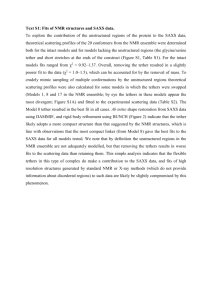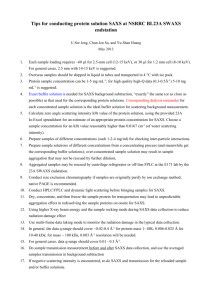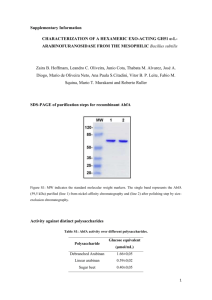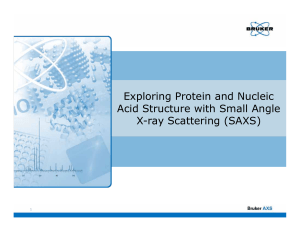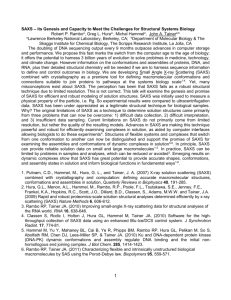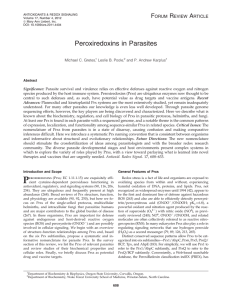Supplementary Information (docx 347K)
advertisement
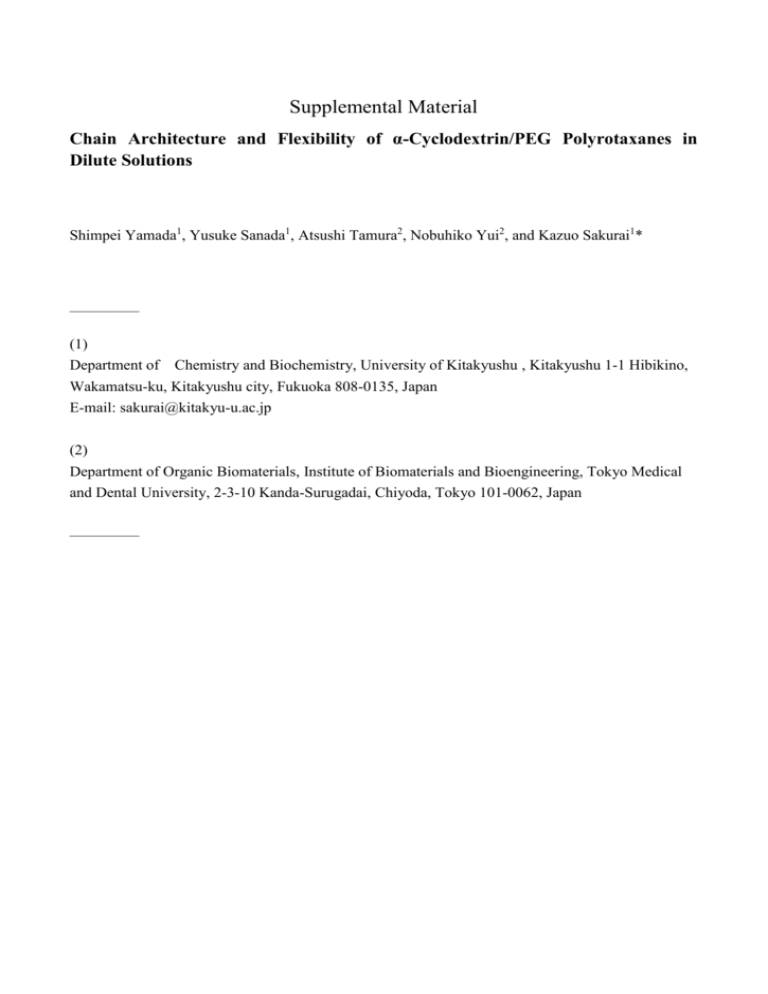
Supplemental Material Chain Architecture and Flexibility of α-Cyclodextrin/PEG Polyrotaxanes in Dilute Solutions Shimpei Yamada1, Yusuke Sanada1, Atsushi Tamura2, Nobuhiko Yui2, and Kazuo Sakurai1* ––––––––– (1) Department of Chemistry and Biochemistry, University of Kitakyushu , Kitakyushu 1-1 Hibikino, Wakamatsu-ku, Kitakyushu city, Fukuoka 808-0135, Japan E-mail: sakurai@kitakyu-u.ac.jp (2) Department of Organic Biomaterials, Institute of Biomaterials and Bioengineering, Tokyo Medical and Dental University, 2-3-10 Kanda-Surugadai, Chiyoda, Tokyo 101-0062, Japan ––––––––– Table of Contents 1. Materials……………………………………………….…………………………………………2 2. Characterization of polyrotaxanes……………………………………………………………...2 3. Synthesis of HEE group-modified polyrotaxanes. ………………………………………….....3 4. Synchrotron SAXS measurements……………………………………………………………...7 5. Light scattering and viscometry measurements………………………………………………..8 6. Additional data…………………………………………………………………………………...9 1 1. Materials α-Cyclodextrin (α-CD) was obtained from Ensuiko Sugar Refining (Tokyo, Japan). α,ω-Bisaminopropyl-poly(ethylene glycol) (PEG-NH2) (Mn = 10,200, Mw/Mn = 1.03) was obtained from NOF (Tokyo, Japan). Poly(ethylene glycol) (PEG-OH) (Mn = 9,810, Mw/Mn = 1.02), N-benzyloxycarbonyl-L-tyrosine (Z-Tyr-OH), and 1,1’-carbonyldiimidazole (CDI) were obtained from Sigma-Aldrich (St. Louis, MO, USA). 4-(4,6-Dimethoxy-1,3,5-triazin-2-yl)-4-methylmorpholinium chloride (DMT-MM) was obtained from Wako Pure Chemical Industries (Osaka, Japan). O-(2-Hydroxyethyl)ethanolamine (HEEA) was obtained from Tokyo Chemical Industry (TCI, Tokyo, Japan). 2. Characterization of polyrotaxanes Size exclusion chromatography (SEC) was carried out on a HLC-8120 system (Tosoh, Tokyo, Japan) equipped with a combination of TSKgel α-4000 and α-2500 columns (Tosoh), eluted with dimethylsulfoxide (DMSO) containing 10 mM LiBr at a flow rate of 0.35 mL/min at 60 ºC. The Mn,SEC and Mw/Mn were calculated based on the PEG calibration standard (Agilent Technologies, Wilmington, DE, USA). 1 H nuclear magnetic resonance (NMR) spectra were recorded on a Bruker Avance III 500 MHz spectrometer (Bruker BioSpin, Rheinstetten, Germany). 2 3. Synthesis of HEE group-modified polyrotaxanes. The PEG/α-CD polyrotaxanes (PRXs) with various number of threading α-CD were prepared by varying feed [α-CD]/[PEG] molar ratio. Typical procedure for the preparation of the PRXs with the number of threading α-CD of 27.7 was as follows (Scheme S1); A saturated solution of α-CD was prepared by dissolving α-CD (4.42 g, 4.55 mmol) in water (30.5 mL). Then, PEG-NH2 (2.0 g, 196 μmol) dissolved in small aliquot of water was added to the α-CD solution, and the mixture was stirred for 24 h at room temperature. After the reaction, the system was freeze-dried for 1 day to obtain a pseudopolyrotaxane as powder. Then, Z-Tyr-OH (2.16 g, 6.86 mmol), DMT-MM (2.17 g, 7.84 mmol), and the pseudopolyrotaxane were allowed to react in methanol (10 mL) for 24 h at room temperature. After the reaction, the precipitate was collected by centrifugation (7,000 rpm, 5 min) and dissolved in DMSO. This solution was poured into water to precipitate the PRX, which was then collected by centrifugation (7,000 rpm, 5 min). This purification process was repeated four times to remove the unreacted reagents, α-CD, and PEG. The recovered solution was freeze-dried to obtain PRX as powder (2.29 g, 30.6% yield based on PEG mol%). The number of threading α-CD in polyrotaxanes was determined by 1H NMR in NaOD/D2O (Figure S1-S3). The PRX (300 mg, 7.96 μmol, 220 μmol of α-CD) and CDI (286 mg, 1.76 mmol) was dissolved in anhydrous DMSO (15 mL), and the reaction mixture was stirred for 24 h at room temperature. Then, HEEA (1.75 mL, 17.6 mmol) was added to the reaction mixture, and the mixture was stirred for a further 24 h at room temperature. After the reaction, the polymer was purified by dialysis against water for 3 days (Spectra/Por 6, molecular weight cut off of 8,000) (Spectrum Laboratories). The recovered solution was freeze-dried to obtain an (2-hydroxyethoxy)ethyl group-modified PRX (HEE-PRX) (406.7 mg). The number of modified HEE groups on PRX and Mn,NMR of the HEE-PRX were determined from 1H NMR spectra in DMSO-d6. 3 Scheme S1. Synthesis scheme for HEE group-modified polyrotaxanes (HEE-PRXs). 4 Figure S1. 1H NMR (500 MHz, NaOD/D2O, 300 K) spectrum of 25CD. Figure S2. 1H NMR (500 MHz, NaOD/D2O, 300 K) spectrum of 34CD. 5 Figure S3. 1H NMR (500 MHz, NaOD/D2O, 300 K) spectrum of 50CD. 6 4. Synchrotron SAXS measurements SAXS measurements were performed at BL-40B2 at SPring-8, Japan. A 30 cm × 30 cm imaging plate (Rigaku R-AXIS VII) detector was placed 2.0 m away from the sample. The wavelengths of the incident beam, denoted by λ, were 0.100 nm. The 2.0 m setups provided the q range of 0.05–3.50 nm−1, where q is the magnitude of the scattering vector defined by q = 4π/λ sin(θ) with the scattering angle of 2θ. A bespoke SAXS vacuum sample chamber was used, and the X-ray transmittance of the samples was determined with an ion chamber located in front of the sample and a Si photodiode for X-ray (Hamamatsu Photonics S8193) behind the sample. A PRX solution was packed in a quart capillary (2 mm Φ, Hilgenberg GmbH) and set in the sample chamber. SAXS from a sample solution was measured at an exposure time of 5 min. The resulting 2D SAXS images were converted to 1D Ilaw(q) versus q profiles by circular averaging. Here, Ilaw(q) was the scattering intensity at q, and to obtain the excess scattering intensity Ilaw(q) of PRX, the scattering from the background due to the buffer, the cell, and density fluctuations was subtracted. 7 5. Light scattering and viscometry measurements Light scattering and viscosity measurements were carried out by use of a Dawn-Heleos-A (Wyatt) and a ViscoStar-II (Wyatt), respectively, coupled with a Shodex GPC-101 system. An amount of 100 μL of solution was injected into a system consisting of a Shodex HPLC pump (DU-H2130) equipped with a Shodex degassing unit (ERC-3125S). The chromatogram was measured with an RI-71S interferometric differential refractive index detector (Shodex). The separation column was consisting of a series of SB-806M and SB-802.5 (Shodex). The mobile phase was a Dulbecco's PBS at 0.8 mL/min. Data acquisition and manipulation were performed using Wyatt’s ASTRA for Windows software (V. 5.34.16). Scattered light intensities at the scattering angles over 14–163° were measured, and their angular dependence was analyzed using a Berry’s plot to determine the weight-averaged molar mass (MW). The specific refractive index increment (∂n/∂c) of PEG, 25CD, 34CD, and 50CD in the phosphate buffer were 0.127, 0.133, 0.135, and 0.164 cm3 g–1, respectively, determined with a DRM-1021 differential refractometer (Otsuka Electronics) at 633 nm and 25 °C. 8 6. Additional data Figure S3. When the length of wormlike cylinder was fixed at the original PEG length (89.2 nm), the calculated SAXS intensity was not reproduced at the low q region for 25CD (See the text) 9 Figure S4. Holtzer plot of the HEE-PRXs. This figure shows the same data and theoretical curves of Figure 3A with the horizontal axis displayed with logarithmic scale. 10
